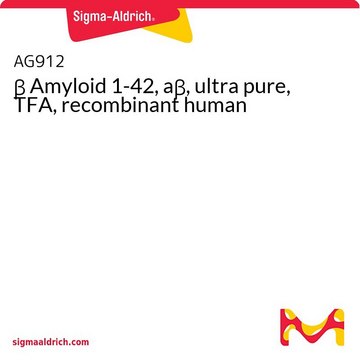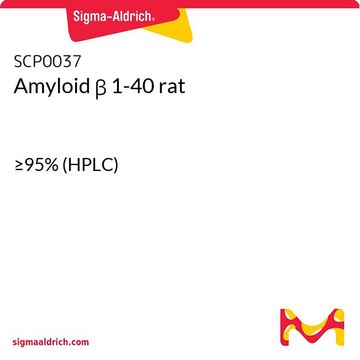SCP0048
Amyloid β 42-1 reverse human
≥95% (HPLC)
Zaloguj sięWyświetlanie cen organizacyjnych i kontraktowych
About This Item
Wzór empiryczny (zapis Hilla):
C203H311N55O60S1
Masa cząsteczkowa:
4514.04
Kod UNSPSC:
12352200
NACRES:
NA.32
Polecane produkty
Próba
≥95% (HPLC)
Formularz
lyophilized
skład
Peptide Content, ≥75%
warunki przechowywania
protect from light
temp. przechowywania
−20°C
Amino Acid Sequence
Ala-Ile-Val-Val-Gly-Gly-Val-Met-Leu-Gly-Ile-Ile-Ala-Gly-Lys-Asn-Ser-Gly-Val-Asp-Glu-Ala-Phe-Phe-Val-Leu-Lys-Gln-His-His-Val-Glu-Tyr-Gly-Ser-Asp-His-Arg-Phe-Glu-Ala-Asp
Zastosowanie
Amyloid β (Aβ) refers to peptides derived from Amyloid precursor protein that vary in length from 36-43 amino acids. Aβ(s) peptides, their peptide fragments and mutated fragments are used to study a wide range of metabolic and regulatory functions including activation of kinases, regulation of cholesterol transport, function as a transcription factor, and regulators of inflammation. Aβ(s) peptides and their peptide fragments are also used to study oxidative stress, metal binding and mechanisms of protein cross-linking in the context of diseases such as Alzheimer′s disease and neurodegeneration.
Ta strona może zawierać tekst przetłumaczony maszynowo.
Kod klasy składowania
11 - Combustible Solids
Klasa zagrożenia wodnego (WGK)
WGK 3
Temperatura zapłonu (°F)
Not applicable
Temperatura zapłonu (°C)
Not applicable
Wybierz jedną z najnowszych wersji:
Certyfikaty analizy (CoA)
Lot/Batch Number
Nie widzisz odpowiedniej wersji?
Jeśli potrzebujesz konkretnej wersji, możesz wyszukać konkretny certyfikat według numeru partii lub serii.
Masz już ten produkt?
Dokumenty związane z niedawno zakupionymi produktami zostały zamieszczone w Bibliotece dokumentów.
Klienci oglądali również te produkty
Kodeeswaran Parameshwaran et al.
Synapse (New York, N.Y.), 61(6), 367-374 (2007-03-21)
The brains of Alzheimer's disease (AD) patients have large numbers of plaques that contain amyloid beta (Abeta) peptides which are believed to play a pivotal role in AD pathology. Several lines of evidence have established the inhibitory role of Abeta
S M Yatin et al.
Neurobiology of aging, 20(3), 325-330 (1999-12-10)
The amyloid beta-peptide (A beta)-associated free radical oxidative stress model for neuronal death in Alzheimer's disease (AD) brain predicts that neuronal protein oxidation is a consequence of A beta-associated free radicals [8]. In this study we have used both in
Lin Wang et al.
Journal of Alzheimer's disease : JAD, 64(3), 957-971 (2018-07-12)
Alzheimer's disease (AD) is characterized by neuritic plaques and neurofibrillary tangles. It is reported that enzymatic degradation of amyloid-β (Aβ) plays a pivotal role in Aβ accumulation and type-2 cannabinoid receptor (CB2R) participates in Aβ processing in the brain; however
U Igbavboa et al.
Neuroscience, 142(3), 655-660 (2006-08-15)
Amyloid beta-protein (Abeta) increases apolipoprotein E (apoE) levels in astrocytes which could alter lipid trafficking. The mechanism for the Abeta-induced increase in apoE levels is not well understood. It is well established that stimulation of beta-adrenergic receptors (betaARs) increases cAMP
Hong Lian et al.
The Journal of neuroscience : the official journal of the Society for Neuroscience, 36(2), 577-589 (2016-01-14)
Increasing evidence supports a role of neuroinflammation in the pathogenesis of Alzheimer's disease (AD). Previously, we identified a neuron-glia signaling pathway whereby Aβ acts as an upstream activator of astroglial nuclear factor kappa B (NF-κB), leading to the release of
Nasz zespół naukowców ma doświadczenie we wszystkich obszarach badań, w tym w naukach przyrodniczych, materiałoznawstwie, syntezie chemicznej, chromatografii, analityce i wielu innych dziedzinach.
Skontaktuj się z zespołem ds. pomocy technicznej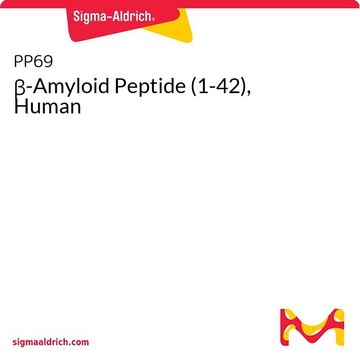
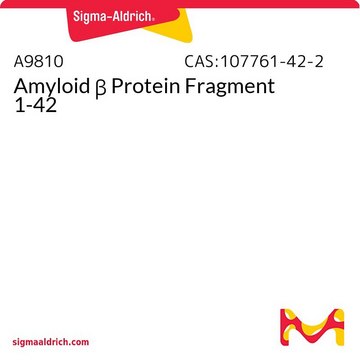

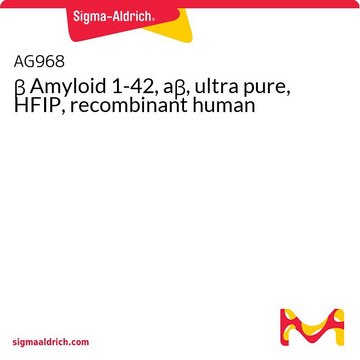




![[Gln22]-Amyloid β 1-40 human ≥95% (HPLC)](/deepweb/assets/sigmaaldrich/product/images/707/874/59f84b84-17c2-494f-b2ae-4ca860b83976/640/59f84b84-17c2-494f-b2ae-4ca860b83976.jpg)


